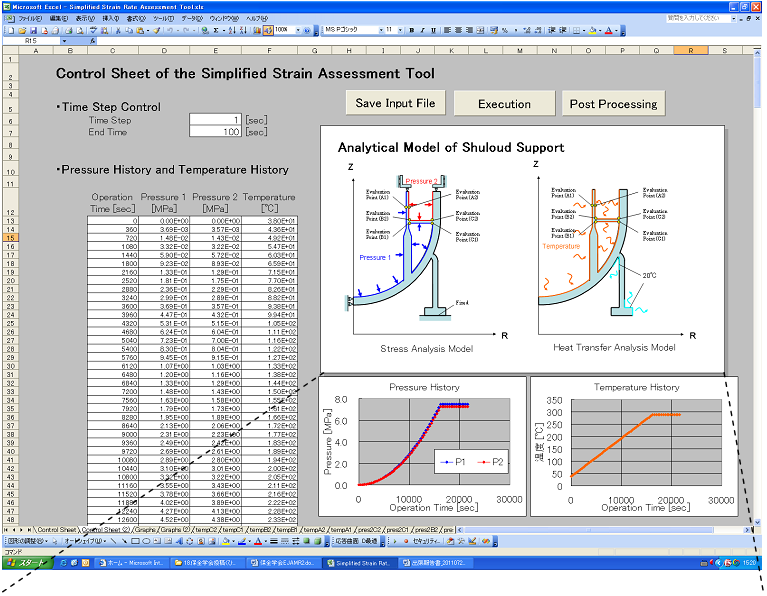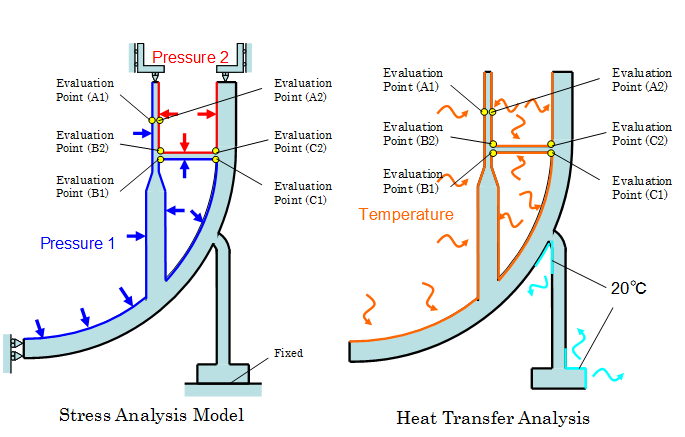Tepco Systems Corporation
Classification
3 - A
It is important to consider the mechanical factor in addition to material and environmental ones to evaluate the risk of Stress Corrosion Cracking (SCC) in nuclear power plants. Especially, it is recognized that the strain rate affects SCC initiation. According to the experimental data shown in Fig.1, SCC susceptibility was most apparent at a strain rate around 4.2 x 10-7 s-1 and less apparent at rates which were higher and lower than this in 150 ºC water with 8ppm Dissolved Oxygen (DO) concentration[1].

Fig. 1Example of Experimental Data on Strain Rate Dependency of SCC Susceptibility [1]
Despite its significant affect on SCC, the actual strain rate of components is not known. To evaluate the strain rate for an each operation procedure by Finite Element Method (FEM) is trouble and practical evaluation methods have not been developed.
To evaluate the strain rate easily for arbitrary operation procedure, we developed a simplified evaluation method of strain rate based on the Green’s function method for a specifically selected point of component. A flow chart of this strain rate evaluation method is shown in Fig. 2. Under this evaluation method, the stress history for unit-step temperature change must be calculated in advance, using the FEM code. The stress history for arbitrary temperature change can be calculated based on the principle of linear superposition. The stain history and the stain rate history can be calculated from the stress history calculated. Similarly, the strain rate for arbitrary pressure change can be also calculated.
This simplified assessment tool can easily calculate the strain rate for an arbitrary plant operating procedure. Therefore this assessment tool can help us seek for better plant operating procedures, with lower susceptibility to SCC in a BWR water environment.

Fig.2 Strain rate evaluation flow chart based on the Green’s function method
Phase 1 : Research and Development Phase
-
Components
Vessels, reactor internals and pipings
ex.
Primary loop re-circulation lines in BWRs
Shroud support in BWRs
Lower shroud in BWRs
Inlet line of steam generators in PWRs
Bottom mounted instrumentations in PWRs
-
Location
Weld joints
-
Materials
Regardless of material
-
Condition
Arbitrary pressure and temperature
-
Easy and High-Speed
The simplified strain rate assessment tool is developed on the platform of Microsoft® Excel®, which is user-friendly, familiar and easy to learn. The screenshot of this tool is shown in Fig.3. This tool enables the user to calculate the strain rate in just a few steps.
In the first step, the user fills arbitrary pressure and temperature histories in the spreadsheet, and presses the button “Save Input File” and “Execution”. Then, strain rate calculation program runs in background and calculation results of the strain rate are stored in output files.
As the tool calculates the strain rate from the liner sum of strain history for the unit-step temperature and pressure transient, calculation time is very short. Table 1 shows the comparison of calculation time between the FEM code (FINAS ver. 20.1) and the developed tool. It is found that the calculation time of the tool is over 100 times faster than that of the FEM code.
In the second step, the user presses the button “Post processing”. Then, calculation results of strain rate are stored and graphs of strain rate history are displayed on the Excel sheet as shown in Fig.4. This tool enables us to check easily and quickly the strain rate in an arbitrary plant operation procedure.


Fig. 3 Screenshot of the simplified strain rate assessment tool (Control sheet)

Fig. 4 Calculation result of the simplified strain rate assessment tool
Table 1 Comparison of calculation time between the FEM code and the simplified strain rate assessment tool

- Useful for determining better plant operation procedure
This tool can calculate the strain rate easily and quickly as above described. Therefore, the tool can help us to develop better plant operating procedures, with lower susceptibility to SCC.
- High-Accuracy
To verify the simplified strain rate assessment tool, the strain rate in the plant start-up condition is calculated using this tool. See the chapter 5, “Example(s) of Application”.
To apply the simplified strain rate assessment tool to Tokai Daini NPP, one of the BWR-5 plants with 1100MWe, the strain rate in the plant start-up condition is calculated using this tool and is then compared to the analytical result from the FEM code. An example of application results is shown in Fig. 5. The strain rate calculated using the simplified assessment tool perfectly agrees with the FEM code result.
To mitigate the environment of reactor water chemistry, hydrogen injection has been applied not only in normal operation but also during plant start-up[2]. Technical backgrounds of strain rate evaluation shown above are described in open literatures[3][4].
For PWR environmental condition, it has not been reported that specific order of strain rate has an influence on SCC, but some report says that environmental fatigue has significant dependency of strain rate on fatigue life of structural materials even in such reductive environment as in PWR primary water. It is considered important, therefore, to have knowledge on strain rate induced by transient event like plant start-up.

Fig.5 Application results of the simplified assessment tool (PLR Line)
- [1] Kikuchi et al., Boshoku Gijutsu (Corrosion Engineering), 32, 497 (1983) (in Japanese).
- [2]A. Abe, H. Tobita, N. Nagata, K. Dozaki and H. Takiguchi, Mitigatim of SCC Initiation on BWR Core Internals by Means of Hydrogen Water Chemistry During Start-Up, ANS, Nuclear Science and Engineering: 149, pp312-324, 2005
- [3]K. Dozaki, H. Chitose, H. Ogawa, and H. Machida, Strain Rate Evaluation of Some Typical Nuclear Power Plant Components During Plant Operation, Proc. of ASME PVP-2010, July18-22, 2010
- [4] K. Dozaki, H. Machida, O. Tsuzuki, H. Ogawa, H. Chitose, Simplified Evaluation Method of Strain Method of Strain Rate Generated on Structural Materials During Plant Start-Up, Proc. of ICONE 19, May 16-19, 2011 Makuhari (Cancelled, but Proceeding was published)





